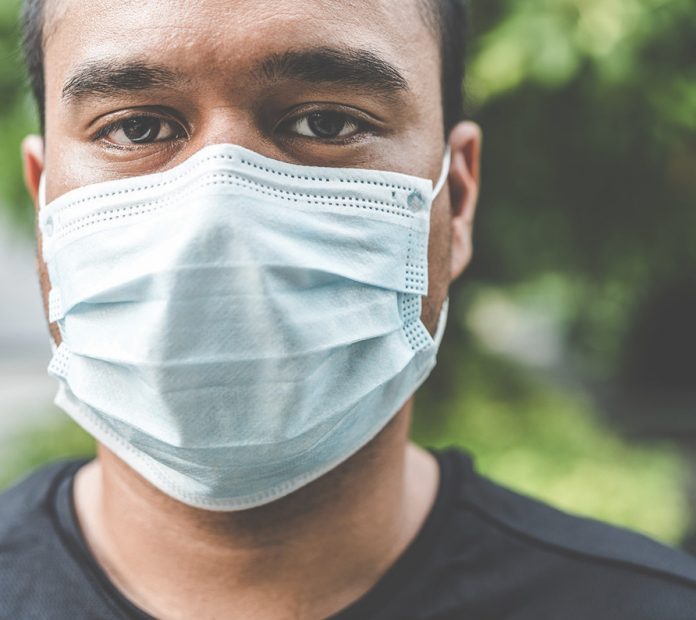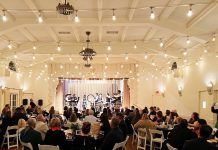The COVID-19 pandemic landed in San Diego county on March 9, 2020 with a woman who had traveled abroad and brought the virus back to this region.
With almost a year of hindsight, what do social service providers think could have been better planned or better executed?
McAlister Institute, a social service agency that partners with county Health and Human Services runs 24 programs across the county that span outpatient mental and behavioral treatment, sober living, drug abuse prevention and homeless outreach including some residential programs, but their resources were stretched thin before the added challenge of a pandemic.
Emergency Physician James Dunford, who worked as an emergency room physician for three decades and now serves as Medical Director at McAlister said “it’s essential that mental health and behavioral health continue in a pandemic” but trying to deal with COVID was like working with overlapping Venn diagrams.
“We know for a fact there are not enough behavioral health resources right now, especially in the south part of the county where we’re the only detox beds, ten male and ten female beds for people coming off the streets with a heroin addiction,” Dunford said.
Already strapped for resources, “COVID derailed a lot of addiction care and forced us to move in different directions,” Dunford said.
Throughout the current COVID pandemic, he observed, “this pressure to keep going in the face of this and you could see that with the services being provided, the risk was not in the work environment.”
McAlister employees, many of whom live in multigenerational households, were hit harder than the clientele they serve, said Dunford and the surge in sick employees, or those who had to isolate along with someone sick at home, directly affected how the agency supplied care.
Employees were stretched thinner than prior to the pandemic, residential programs were locked down for safety with an added fear for clients, and hours spent on new safety measures were not being spent on mental and behavioral health.
“The lion’s share of the impact on us has been with sick employees and trying to keep things running. In December, we had several new cases every day with employees getting quarantined and re-quarantined. A lot of times, it’s coming from the homes where people live. Trying to keep everyone protected has been really hard, especially in the absence of reliable testing,” Dunford said.
For that, he looks to the Trump administration and the federal government to learn their lesson.
“I don’t think anyone can defend not having enough masks in the future or deny that the United States should have its own supply. We also have to learn we can’t go through any sort of watered down, every-state-for-itself approach. A Federal government is supposed to prepare itself,” Dunford said.
Communication also needs to improve at all levels, although that is not a new lesson but one that needs to be relearned, according to Dunford who compared the recent COVID response to San Diego’s Anthrax bioterrorism scare from 2011, where the Centers for Disease Control came to San Diego to discuss messaging ahead of a crisis.
“It was all about messaging: If this comes to the community, how are we going to talk to the public? Here’s what we know, what we don’t know,” Dunford said.
Locally, social services have to be made readily available to the communities they are intended to serve, he said.
Looking back to the early 1980’s, he recounts how Somali refugees were discouraged from calling 911 for basic medical care but that regular practice did not stop until Rady Children’s built a care center.
“We learned from that, or should have learned that people need things brought to them in their own way,” Dunford said.
In this case, “the lesson learned is that we need people to go out and vaccinate our homeless population because they aren’t going to go to the doctor on their own,” and until they get the resources in their own way, they will remain unvaccinated.
“Someone needs to strap on a backpack and go find them,” Dunford said.
Dunford, who is also Professor Emeritus at University of California, San Diego in Emergency Medical Services and was appointed as chair of the California Emergency Medical Services Authority by California Senator Toni Atkins said one win is seeing CalFire vaccinating senior citizens in nursing homes.
“Even through the last Hepatitis outbreak, paramedics could not vaccinate. Now, we’re rethinking the teams that are involved to tackle vaccination through social services,” Dunford said.
That same senior population is the one Veterans of Foreign Wars District 1 Commander Paula Jansen most worries about. The organization, established to foster camaraderie among United States veterans and advocate on their behalf relies a great deal on large-group gatherings, outings, volunteer service projects, community outreach and reassurance that a post member always has a place to go and is never truly alone.
With physical distancing measures in place, post activity came to a haltalong with meal service, mental health outreach events and other programs that were, by their nature, designed to be social.
Jansen, who oversees posts that serve over 11,000 veterans across the county said the most important lesson learned over the past year was how to communicate with and provide social services to an aging population that is not always tech-savvy.
She said she believes the county could have safely set up Resource Fairs, not unlike food distribution points.
“If you can go to the grocery store, you can drive through a resource fair and be handed printed information,” Jansen said.
Jansen realized she had to set up a system of communication for her most elderly and isolated veterans because “if we’re not contacting them, we can’t give them the services they need”.
After she gathered all the emails that had bounced back from individual VFW posts commanders, Jansen called those veterans by phone to check on them, then set up an application that places hundreds of outbound calls at once to leave an informative phone message.
Organization leaders need to set up a plan “before they are in crisis mode,” Jansen said.
She believes anyone can learn and plan ahead, gives the example of a 93-year Navy veteran and California VFW Parliamentarian Buford Maples who has grown comfortable sending Jansen emails on a regular basis.
“I look at him and think, if I could only have a sliver of his knowledge, of all he has learned in his life— well, if he can figure out how to email back and forth with me, everyone can. We just need to do it when we’re not locked down and people can ask as many questions as they need to,” Jansen said.
The commander also said there is a lesson to be learned in how seniors were advised at the outset to stay home as much as possible when sometimes, the only family and support network they have is their circle of friends.
“For some of our older veterans, this is like their living room where they socialize with each other. To close our doors on the same five people who are here every night like a family of five doesn’t make sense and it left them isolated,” Jansen said.
Her final suggestion: that authorities needed to have a more precise plan in place for disseminating information.
“Give us real numbers and truth, accuracy. Give us knowledge,” Jansen said.
San Ysidro Health Patient Engagement Director Alejandrina Arevalo has spent the past year gathering numbers and knowledge in East county and South Bay communities. A federally qualified health center, San Ysidro Health recently acquired Mountain Health clinic in Alpine and provides healthcare-related social services to underserved and vulnerable communities.
When the pandemic hit, the group noticed it was getting referrals to their El Cajon emergency food pantry from people in South Bay, so they decided to open a second distribution point in that area.
“In January, we had 690 families in El Cajon and by April we were at 1,600 a month for the two locations,” Arevalo said.
When the number of families ballooned to 2,900 in June, Arevalo began looking for patterns and hypothesizes that is when many people were furloughed, right as schools closed and transportation routes were decreased.
“We learned there are recurring families that always come for food,” Arevalo said and “you’re not going to investigate the bottom line during a pandemic” but those costs add up so the organization made a concerted effort to redirect families in need to larger food banks.
The group printed a resource page with four available food banks in South Bay and El Cajon and began distributing the sheet with advance warning a month before shutting down distribution.
San Ysidro Health also commuted their lesson learned into a lesson taught for arriving families, added information to their one-sheet on how and where families could apply for Woman, Infants and Children, or WIC, the federally-funded supplemental nutrition program that provides supplemental foods, health care referrals, and nutrition education to low-income families.
In addition to Arevalo’s observations, San Ysidro Health Research Manager Adriana Bearse said one of the lessons she believes the group learned is that, as a trusted middleman between county directives and providers in communities, “we have to meet people where they are, like understanding cultural competencies and providing information in the right languages” in neighborhoods with large immigrant populations.
“We have a large Arabic-speaking population in East county, a large Latino, Spanish-speaking population in South county. Providing information in a way that will resonate with the community is necessary,” Bearse said.
Recognizing a divide was not a new situation, she said, but the real lesson was in recognizing how wide the divide really is.
“A lot of the challenges and with those challenges the things we need to learn about and change are things that existed before COVID, that have existed for a very long time. If we are able, moving forward, to allocate resources there, then maybe in the future we can also continue to address the barriers,” Bearse said.
Like Dunford, Bearse believes one reason some neighborhoods have been hit especially hard by COVID is a high concentration of essential workers who live in those areas don’t have the choice to work from home.
“They have to go to work to provide for their family. Then, you have multigenerational households where everyone is going out to work to pay rent and buy groceries, but has limited access to resources,” Bearse said.
For those populations, learning how to better design transportation and provide internet access are just as critical as health support, she said.
Partnerships were a large part of the answer, Bearse said, including existing partnerships established with local schools prior to COVID, not unlike how Jansen said the systems set up prior to ‘crisis mode’ are more effective. As students were already comfortable navigating online, clinic staff learned to reach through teachers to engage parents and offer out personal protective gear like masks and hand sanitizer.
“We’ve been able to do things like join virtual sessions with teachers; we can access kids in school,” Bearse said.
Judith Shaplin served as Chief Executive Officer of Mountain Health clinic in Alpine before San Ysidro Health acquired the location. Now serving as San Ysidro Health Vice President of Social and Rural Health Services, Shaplin said that particular clinic offered unique lessons to be learned over the past year as it had a pre-existing senior citizen nutrition program, essentially offering a before-and-after comparison.
“We had to rapidly convert our congregate meals to delivery services for seniors. The lesson learned was really in how we communicate with our seniors who are not computer savvy, ” Shaplin said.
Additionally, she said, workers wanted to keep the population safely out of the public but recognized congregate meals were about social gathering and interaction, not unlike the friends-as-family gathering each evening that Jansen described at the VFW post.
Not unlike Jansen, they set up a system to check on seniors who clearly were not communicating online.
“We literally went door to door and checked on seniors, reached out through churches, reached out through community leaders, at the height of it we went from 140 to over 500 senior enrollees because we actively solicited them to ask if they were okay and went from one meal to two and in some cases three meals a day.
Initially, volunteers dropped meals off at homes, but Shaplin said that proved exhausting as their areas ranges 950 square miles, from Alpine to Campo and as volunteers began to show signs of COVID fatigue, staff learned to have backup on hand if possible.
They also watched the cost of their food pantry soar as they went from fewer than 50 boxes of food each month to almost 400.
We also have a food pantry and went from less than 50 boxes a month to 350 to almost 400 boxes.
“The county definitely could have increased the funding for non-profit programs. They needed to understand the increased cost of supplies. As an example, all of a sudden the food trays went from $80 to $300 for 500 trays,” Shaplin said.
While the cost of food has increased, the nominal donations some seniors gave at in-person lunches are not being collected, and the group is now supplying senior citizens with 4,000 meals monthly, doubled from pre-pandemic days.
Shaplin says there is a final lesson to be had on mental health funding, Like Bearse, she says the lesson is not about a need for funding, but for how dire the situation really is.
“Mental and behavioral health issues have been critical needs throughout our nation, including our county for a very long time. Nobody wants to talk about it and it’s underfunded. I’ve been in this field for over 35 years now and it’s never been funded as it should be. The pandemic really showed mental health needs to be a top-three priority,” Shaplin said.
There is always a silver lining though, she said, and throughout the pandemic she learned and relearned that “difficult times allow people to rise and bring their talents to extraordinary levels,” as they do the best they can.
“It doesn’t mean there aren’t difficulties, challenges and obstacles, but you find ways to go around or under them. You don’t allow it to stop you, you just do it,” Shaplin said.














